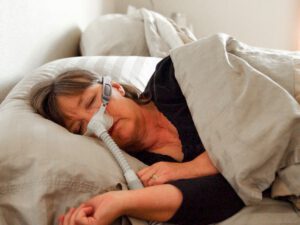Obstructive sleep apnea-hypopnea syndrome (OSAHS or OSA, the latest will be used in this text) is characterised by repetitive episodes of airflow reduction (hypopnea) or cessation (apnoea) due to upper airway collapse during sleep. In addition to this, OSAHS is “a clinical picture of excessive sleepiness, cognitive-behavioural, respiratory, cardiac, metabolic, or inflammatory disorders secondary to repeated episodes of obstruction of the upper airway during sleep” (Spanish Society of Sleep. Sociedad Española de Sueño. Tratado de Medicina del Sueño. Ed Panamericana. 2015)
How and why does Obstructive Sleep Apnoea occur?
Try stopping breathing for one minute, and you will see what happens. The same sensation and consequences happen in patients with obstructive sleep apnoea but are repeated all night long every day while the person sleeps! Sometimes this occurs for more than one minute. (link síndrome de apnea obstructiva del sueño, ¿Asesino silente? – Pedir Cita)
What are the symptoms of obstructive sleep apnoea?
- Disturbances in breathing during sleep: snoring, gasping, and apnoeas.
- Interrupted sleep: frequent arousals and awakenings, poor sleep quality, restless sleep. Some people might sleep all night and even during the day. However, they might feel tired and report “they did not rest at all”. A common cause is waking up to urinate at night (nocturia).
- Daytime symptoms: drowsiness, fatigue, low mood, depression, irritability, and low libido (erectile dysfunction).
- Evident deterioration in the performance of daily tasks affects the patient’s quality of life; this could include: difficulties in the workplace, the interaction of social life, and sexual functions.
Do I suffer from obstructive sleep apnoea?
Three conditions suggest with high probability that a person suffers from obstructive sleep apnoea:
- Snoring or witnessed apnoeas.
- Waking up tired or being tired during the day, falling asleep or dozing off while performing daytime activities.
- Being obese OR hypertensive.
(EN EL SIGUIENTE LINK PUEDE USTED COMPROBAR SI TIENE RIESGO DE PADECER DE ESTA CONDICIÓN – Formulario Berlín… somnolencia stop bang, ESS and BMI)
How obstructive sleep apnoea occurs in the body? What are the risk factors for OSA?
Obesity and a thick neck is the most common cause. However, anything that makes the airway in the throat narrower can cause that problem. Also, anything that relaxes the patient’s muscles.
Male gender. In men, the fat tends to be deposited in the torso, including the neck.
Menopause.
Craniofacial features and abnormalities in soft and hard tissues in the mouth or throat (adenoids, hypertrophic tonsils, nasal polyps, micrognathia, retrognathia, macroglossia, etc.).
Diseases such as cardiopulmonary dysfunctions, diabetes, muscle hypotonia, as seen in brain problems (strokes), neurological conditions, and Down’s syndrome, among others.
Tobacco, alcohol or sedatives (sleeping pills).
Ageing.






